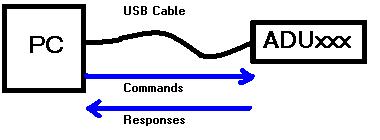 AduHid Quick Start Tutorial - with Visual Basic AduHid Quick Start Tutorial - with Visual Basic
This tutorial describes a Visual Basic program that communicates with an ADU device.
A Quick Start Tutorial is also available for the C
language.
AduHid DLL
The AduHid DLL controls an ADU USB device. The main channel of communication between
the PC and the ADU USB device is the ADU Device Pipe.
ADU Device Pipe
- sends commands to the ADU device
- receives responses from the ADU device

Declaring a Handle
A handle is required to control the device pipe connection. Declare it in the (General)
(Declarations) of the form's code.
Dim aduHandle As Long
Establishing a Connection
Establish a connection between the PC and the ADU USB device by calling AduDeviceOpen.
The function returns a handle that is required in all subsequent function calls.
aduHandle = OpenAduDevice(0)
Writing Commands
Send commands to the ADU USB device with the AduDeviceWrite function. The example shows
a query for the status of relay 1.
Dim iRC As Long
iRC = WriteAduDevice(aduHandle, "RPK1", 4, 0, 0)
Reading Responses
Read the response from the ADU USB device with the AduDeviceRead function. The example
code retrieves the results for the preceding status query.
Dim iRC As Long
Dim sResponse As String * 8
iRC = ReadAduDevice(aduHandle, sResponse, 7, 0, 0)
After the ReadAduDevice function finishes the sBuffer contains the status of relay 1,
either 0 (off) or 1 (on).
Note: This sample program is so minimal that the only way to see the results is to set a
breakpoint on the ReadAduDevice statement and inspect the sResponse field with the
debugger.
Closing the Connection
Close the connection to the ADU USB device with the AduDeviceClose function.
CloseAduDevice (aduHandle)
Function Declarations
The AduHid functions are declared in a module that must be added to the Visual Basic
project. Copy the following into the (General) (Declarations) of a new module.
Declare Function OpenAduDevice Lib "AduHid.DLL" _
(ByVal iTimeout As Long) As Long
Declare Function WriteAduDevice Lib "AduHid.DLL" _
(ByVal aduHandle As Long, ByVal lpBuffer As String, _
ByVal lNumberOfBytesToWrite As Long, _
ByRef lBytesWritten As Long, ByVal iTimeout As Long) As Long
Declare Function ReadAduDevice Lib "AduHid.DLL" _
(ByVal aduHandle As Long, ByVal lpBuffer As String, _
ByVal lNumberOfBytesToRead As Long, _
ByRef lBytesRead As Long, ByVal iTimeout As Long) As Long
Declare Function CloseAduDevice Lib "AduHid.DLL" _
(ByVal iHandle As Long) As Long
Minimal Program Listing
Here is the source code for the minimal program.
Form1.frm
VERSION 5.00
Begin VB.Form Form1
Caption = "Form1"
ClientHeight = 3135
ClientLeft = 90
ClientTop = 375
ClientWidth = 4620
LinkTopic = "Form1"
ScaleHeight = 3135
ScaleWidth = 4620
StartUpPosition = 3 'Windows Default
Begin VB.CommandButton Close
Caption = "Close"
Height = 495
Left = 3240
TabIndex = 3
Top = 2040
Width = 1215
End
Begin VB.CommandButton Read
Caption = "Read"
Height = 495
Left = 3240
TabIndex = 2
Top = 1440
Width = 1215
End
Begin VB.CommandButton Write
Caption = "Write"
Height = 495
Left = 3240
TabIndex = 1
Top = 840
Width = 1215
End
Begin VB.CommandButton Open
Caption = "Open"
Height = 495
Left = 3240
TabIndex = 0
Top = 240
Width = 1215
End
End
Attribute VB_Name = "Form1"
Attribute VB_GlobalNameSpace = False
Attribute VB_Creatable = False
Attribute VB_PredeclaredId = True
Attribute VB_Exposed = False
Dim aduHandle As Long
Private Sub Close_Click()
CloseAduDevice (aduHandle)
End Sub
Private Sub Open_Click()
aduHandle = OpenAduDevice(0)
End Sub
Private Sub Read_Click()
Dim iRC As Long
Dim sResponse As String * 8
iRC = ReadAduDevice(aduHandle, sResponse, 7, 0, 0)
End Sub
Private Sub Write_Click()
Dim iRC As Long
iRC = WriteAduDevice(aduHandle, "RPK1", 4, 0, 0)
End Sub
Module1.bas
Attribute VB_Name = "Module1"
Declare Function OpenAduDevice Lib "AduHid.DLL" _
(ByVal iTimeout As Long) As Long
Declare Function WriteAduDevice Lib "AduHid.DLL" _
(ByVal aduHandle As Long, ByVal lpBuffer As String, _
ByVal lNumberOfBytesToWrite As Long, _
ByRef lBytesWritten As Long, ByVal iTimeout As Long) As Long
Declare Function ReadAduDevice Lib "AduHid.DLL" _
(ByVal aduHandle As Long, ByVal lpBuffer As String, _
ByVal lNumberOfBytesToRead As Long, _
ByRef lBytesRead As Long, ByVal iTimeout As Long) As Long
Declare Function CloseAduDevice Lib "AduHid.DLL" _
(ByVal iHandle As Long) As Long
Additional Checks
A production program requires checks to ensure correct operation. Read the other pages
on this web site for more information.
|